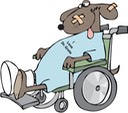Geriatric Neuropathy In The Dog: One of the most common reasons people call me is because their dog is having difficulty getting up or lying down. The perception is that it’s “horrible” arthritis or "hip dysplasia." This is often their veterinarian’s opinion also. The reality is that it is an age related neuropathy (nerve dysfunction) that is causing lack of feeling to the rear legs. This results in weakness and difficulty walking (especially on slippery surfaces like wood, laminate or tile). A similar condition is seen in elderly people and it’s called peripheral neuropathy. Because this condition in the dog is not well documented, veterinarians are taught that 90% of rear leg weakness is caused by intervertebral disk disease. This is where one of the cartilage disks between two vertebrae has degenerated and moved out of place putting pressure on the spinal cord. In many cases, steroids are used for treatment and because this class of medication causes muscle atrophy (shrinkage), the weakness gets worse. Most older dogs have some degree of arthritis, but this generally doesn’t cause rear leg weakness with nerve involvement. The discomfort associated with arthritis can be effectively treated with NSAIDS specifically formulated for use in the dog. This neurological condition is not preventable and is not treatable. It is also progressive and will eventually result in complete, or nearly complete, loss of use of the rear limbs. However, there are many things that can be done to help the dog to function (with help) better. These involve floor coverings like yoga mats or rubber backed throw rugs, help harnesses with handles or other methods of support. Please call for more information. I am happy to discuss this with you.
Canine Cognitive Dysfunction (CCD - Dementia): This, like neuropathy, is common in the aging pet and is seen in both cats and dogs. It is almost a mirror image of what is seen in people and the signs can be similar. It is a behavioral syndrome with changes such as disorientation, sleep-wake cycle disturbances, house soiling, vocalization (crying, moaning, yelping and barking) and changes in activity. There can also be changes in the interactions with their people where they have to be with one person constantly, or, in some cases, want to have minimal contact. Aggression can also be seen. Getting caught in a corner or under furniture often occurs. The vocalization is seldom a sign of pain, but is often associated with anxiety and/or disorientation. The dog is a conditioned creature and their existence is based around what they have been conditioned to do or act. When they are unable to function in their normal routines, they can become anxious. Unfortunately, there are no specific treatments. Hill’s has a prescription diet that their research indicates can be helpful. Gabapentin can be helpful to improve the night time sleep schedule. Anti-anxiety medications such as Trazodone may be used to diminish anxiety. The most important aspect is to understand what is going on. Please call to discuss.

